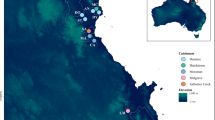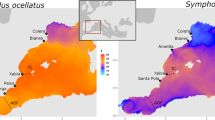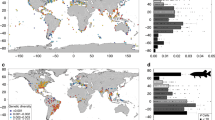Abstract
It is well recognized that environmental degradation caused by human activities can result in dramatic losses of species and diversity. However, comparatively little is known about the ability of biodiversity to re-emerge following ecosystem recovery. Here, we show that a European whitefish subspecies, the gangfisch Coregonus lavaretus macrophthalmus, rapidly increased its ecologically functional diversity following the restoration of Lake Constance after anthropogenic eutrophication. In fewer than ten generations, gangfisch evolved a greater range of gill raker numbers (GRNs) to utilize a broader ecological niche. A sparse genetic architecture underlies this variation in GRN. Several co-expressed gene modules and genes showing signals of positive selection were associated with GRN and body shape. These were enriched for biological pathways related to trophic niche expansion in fishes. Our findings demonstrate the potential of functional diversity to expand following habitat restoration, given a fortuitous combination of genetic architecture, genetic diversity and selection.
This is a preview of subscription content, access via your institution
Access options
Access Nature and 54 other Nature Portfolio journals
Get Nature+, our best-value online-access subscription
$29.99 / 30 days
cancel any time
Subscribe to this journal
Receive 12 digital issues and online access to articles
$119.00 per year
only $9.92 per issue
Buy this article
- Purchase on Springer Link
- Instant access to full article PDF
Prices may be subject to local taxes which are calculated during checkout





Similar content being viewed by others
Data availability
The sequence datasets have been deposited in the National Center for Biotechnology Information Sequence Read Archive with the BioProject accession code PRJNA497182 (corresponding to BioSample accessions SAMN10250325 to SAMN10250521). Phenotype and ecological data are available at the ‘Enlighten: Research Data’ repository of the University of Glasgow: https://doi.org/10.5525/gla.researchdata.680.
References
Hautier, Y. et al. Anthropogenic environmental changes affect ecosystem stability via biodiversity. Science 348, 336–340 (2015).
Hendry, A. P., Gotanda, K. M. & Svensson, E. I. Human influences on evolution, and the ecological and societal consequences. Philos. Trans. R. Soc. B 372, 20160028 (2017).
Des Roches, S. et al. The ecological importance of intraspecific variation. Nat. Ecol. Evol. 2, 57–64 (2018).
Vonlanthen, P. et al. Eutrophication causes speciation reversal in whitefish adaptive radiations. Nature 482, 357–362 (2012).
Taylor, E. B. et al. Speciation in reverse: morphological and genetic evidence of the collapse of a three‐spined stickleback (Gasterosteus aculeatus) species pair. Mol. Ecol. 15, 343–355 (2006).
Hendry, A. P., Farrugia, T. H. O. J. & Kinnison, M. T. Human influences on rates of phenotypic change in wild animal populations. Mol. Ecol. 17, 20–29 (2008).
Rudman, S. M. & Schluter, D. Ecological impacts of reverse speciation in threespine stickleback. Curr. Biol. 26, 490–495 (2016).
Bullock, J. M., Aronson, J., Newton, A. C., Pywell, R. F. & Rey-Benayas, J. M. Restoration of ecosystem services and biodiversity: conflicts and opportunities. Trends Ecol. Evol. 26, 541–549 (2011).
Alexander, T. J., Vonlanthen, P. & Seehausen, O. Does eutrophication-driven evolution change aquatic ecosystems? Philos. Trans. R. Soc. B 372, 20160041 (2017).
Gilman, R. T. & Behm, J. E. Hybridization, species collapse, and species reemergence after disturbance to premating mechanisms of reproductive isolation. Evolution 65, 2592–2605 (2011).
Yeaman, S. & Whitlock, M. C. The genetic architecture of adaptation under migration–selection balance. Evolution 65, 1897–1911 (2011).
Schluter, D. Evidence for ecological speciation and its alternative. Science 323, 737–741 (2009).
Maan, M. E. & Seehausen, O. Ecology, sexual selection and speciation. Ecol. Lett. 14, 591–602 (2011).
Nümann, W. Attempt of a classification of the coregonines in the Lake of Constance with regard to the so-called blaufelchen by combination of several characteristics. Arch. Hydriobiol. 82, 500–521 (1978).
Hirsch, P. E., Eckmann, R., Oppelt, C. & Behrmann-Godel, J. Phenotypic and genetic divergence within a single whitefish form—detecting the potential for future divergence. Evol. Appl. 6, 1119–1132 (2013).
Jochimsen, M. C., Kümmerlin, R. & Straile, D. Compensatory dynamics and the stability of phytoplankton biomass during four decades of eutrophication and oligotrophication. Ecol. Lett. 16, 81–89 (2013).
Thomas, G., Quoss, H., Hartmann, J. & Eckmann, R. Human‐induced changes in the reproductive traits of Lake Constance common whitefish (Coregonus lavaretus). J. Evol. Biol. 22, 88–96 (2009).
Lundsgaard-Hansen, B., Matthews, B., Vonlanthen, P., Taverna, A. & Seehausen, O. Adaptive plasticity and genetic divergence in feeding efficiency during parallel adaptive radiation of whitefish (Coregonus spp.). J. Evol. Biol. 26, 483–498 (2013).
Harrod, C., Mallela, J. & Kahilainen, K. K. Phenotype–environment correlations in a putative whitefish adaptive radiation. J. Anim. Ecol. 79, 1057–1068 (2010).
Østbye, K., Bernatchez, L., Naesje, T. F., Himberg, K.-J. M. & Hindar, K. Evolutionary history of the European whitefish Coregonus lavaretus (L.) species complex as inferred from mtDNA phylogeography and gill-raker numbers. Mol. Ecol. 14, 4371–4387 (2005).
Quevedo, M., Svanbäck, R. & Eklöv, P. Intrapopulation niche partitioning in a generalist predator limits food web connectivity. Ecology 90, 2263–2274 (2009).
Behrmann-Godel, J. Parasite identification, succession and infection pathways in perch fry (Perca fluviatilis): new insights through a combined morphological and genetic approach. Parasitology 140, 509–520 (2013).
Vonlanthen, P. et al. Divergence along a steep ecological gradient in lake whitefish (Coregonus sp.). J. Evol. Biol. 22, 498–514 (2009).
Luczynski, M., Rösch, R., Vuorinen, J. A. & Brzuzan, P. Biochemical genetic study of sympatric Lake Constance whitefish (Coregonus lavaretus) populations: blaufelchen and gangfisch. Aquat. Sci. 57, 136–143 (1995).
Gingerich, P. D. Quantification and comparison of evolutionary rates. Am. J. Sci. 293, 453–478 (1993).
Hamilton, J. A. & Miller, J. M. Adaptive introgression as a resource for management and genetic conservation in a changing climate. Conserv. Biol. 30, 33–41 (2016).
Shafer, A. B. A. & Wolf, J. B. W. Widespread evidence for incipient ecological speciation: a meta-analysis of isolation-by-ecology. Ecol. Lett. 16, 940–950 (2013).
Laporte, M. et al. RAD-QTL mapping reveals both genome-level parallelism and different genetic architecture underlying the evolution of body shape in lake whitefish (Coregonus clupeaformis) species pairs. G3 5, 1481–1491 (2015).
Chaves, J. A. et al. Genomic variation at the tips of the adaptive radiation of Darwin’s finches. Mol. Ecol. 25, 5282–5295 (2016).
Pfeifer, S. P. et al. The evolutionary history of Nebraska deer mice: local adaptation in the face of strong gene flow. Mol. Biol. Evol. 35, 792–806 (2018).
Cruickshank, T. E. & Hahn, M. W. Reanalysis suggests that genomic islands of speciation are due to reduced diversity, not reduced gene flow. Mol. Ecol. 23, 3133–3157 (2014).
Burri, R. Interpreting differentiation landscapes in the light of long‐term linked selection. Evol. Lett. 1, 118–131 (2017).
Delmore, K. E. et al. Comparative analysis examining patterns of genomic differentiation across multiple episodes of population divergence in birds. Evol. Lett. 2, 76–87 (2018).
Gagnaire, P.-A., Normandeau, E., Pavey, S. A. & Bernatchez, L. Mapping phenotypic, expression and transmission ratio distortion QTL using RAD markers in the lake whitefish (Coregonus clupeaformis). Mol. Ecol. 22, 3036–3048 (2013).
Jacobs, A., Womack, R., Chen, M., Gharbi, K. & Elmer, K. Significant synteny and co-localization of ecologically relevant quantitative trait loci within and across species of salmonid fishes. Genetics 207, 741–754 (2017).
Ranz, J. M. & Machado, C. A. Uncovering evolutionary patterns of gene expression using microarrays. Trends Ecol. Evol. 21, 29–37 (2006).
Gibson, G. The environmental contribution to gene expression profiles. Nat. Rev. Genet. 9, 575–581 (2008).
Jeukens, J., Renaut, S., St-Cyr, J., Nolte, A. W. & Bernatchez, L. The transcriptomics of sympatric dwarf and normal lake whitefish (Coregonus clupeaformis spp., Salmonidae) divergence as revealed by next-generation sequencing. Mol. Ecol. 19, 5389–5403 (2010).
Park, P. J. & Bell, M. A. Variation of telencephalon morphology of the threespine stickleback (Gasterosteus aculeatus) in relation to inferred ecology. J. Evol. Biol. 23, 1261–1277 (2010).
Conejeros, P. et al. Differentiation of sympatric Arctic char morphotypes using major histocompatibility class II genes. Trans. Am. Fish. Soc. 143, 586–594 (2014).
Jacobs, A. et al. Convergence in form and function overcomes non-parallel evolutionary histories in Arctic charr. Preprint at https://doi.org/10.1101/265272 (2018).
Ahi, E. Signalling pathways in trophic skeletal development and morphogenesis: insights from studies on teleost fish. Dev. Biol. 420, 11–31 (2016).
Yohannes, E., Grimm, C., Rothhaupt, K.-O. & Behrmann-Godel, J. The effect of parasite infection on stable isotope turnover rates of δ15N, δ13C and δ34S in multiple tissues of Eurasian perch Perca fluviatilis. PLoS ONE 12, e0169058 (2017).
Siwertsson, A., Knudsen, R., Adams, C. E., Præbel, K. & Amundsen, P. A. Parallel and non-parallel morphological divergence among foraging specialists in European whitefish (Coregonus lavaretus). Ecol. Evol. 3, 1590–1602 (2013).
Rohlf, F. J. TpsDig (Department of Ecology and Evolution, State University of New York, Stony Brook, 2004); http://life.bio.sunysb.edu/morph/
Klingenberg, C. P. MorphoJ: an integrated software package for geometric morphometrics. Mol. Ecol. Resour. 11, 353–357 (2011).
Klingenberg, C. P. & McIntyre, G. S. Geometric morphometrics of developmental instability: analyzing patterns of fluctuating asymmetry with Procrustes methods. Evolution 52, 1363–1375 (1998).
Benjamini, Y., Hochberg, Y., Benjamini, Y. & Hochberg, Y. Controlling the false discovery rate: a practical and powerful approach to multiple testing. J. R. Stat. Soc. B 57, 289–300 (1995).
Haldane, J. B. S. Suggestions as to quantitative measurement of rates of evolution. Evolution 3, 51–56 (1949).
Recknagel, H., Jacobs, A., Herzyk, P. & Elmer, K. R. Double-digest RAD sequencing using Ion Proton semiconductor platform (ddRADseq-ion) with nonmodel organisms. Mol. Ecol. Resour. 15, 1316–1329 (2015).
Andrews, S. FastQC: A Quality Control Tool for High Throughput Sequence Data (2010); http://www.bioinformatics.babraham.ac.uk/projects/fastqc/
Catchen, J. M. et al. Stacks: building and genotyping loci de novo from short-read sequences. G3 1, 171–182 (2011).
Danecek, P. et al. The variant call format and VCFtools. Bioinformatics 27, 2156–2158 (2011).
Chang, C. C. et al. Second-generation PLINK: rising to the challenge of larger and richer datasets. GigaScience 4, 1–16 (2015).
Lischer, H. E. L. & Excoffier, L. PGDSpider: an automated data conversion tool for connecting population genetics and genomics programs. Bioinformatics 28, 298–299 (2012).
Alexander, D. H. & Novembre, J. Fast model-based estimation of ancestry in unrelated individuals. Genome Res. 19, 1655–1664 (2009).
Jombart, T. adegenet: a R package for the multivariate analysis of genetic markers. Bioinformatics 24, 1403–1405 (2008).
Jombart, T. & Ahmed, I. adegenet 1.3-1: new tools for the analysis of genome-wide SNP data. Bioinformatics 27, 3070–3071 (2011).
Meirmans, P. G. & Tienderen, P. H. genotype and genodive: two programs for the analysis of genetic diversity of asexual organisms. Mol. Ecol. Notes 4, 792–794 (2004).
Weir, B. S. & Cockerham, C. C. Estimating F-statistics for the analysis of population structure. Evolution 38, 1358–1370 (1984).
Pickrell, J. K. & Pritchard, J. K. Inference of population splits and mixtures from genome-wide allele frequency data. PLoS Genet. 8, e1002967 (2012).
Excoffier, L., Dupanloup, I., Huerta-Sánchez, E., Sousa, V. C. & Foll, M. Robust demographic inference from genomic and SNP data. PLoS Genet. 9, e1003905 (2013).
Gutenkunst, R. N., Hernandez, R. D., Williamson, S. H. & Bustamante, C. D. Inferring the joint demographic history of multiple populations from multidimensional SNP frequency data. PLoS Genet. 5, e1000695 (2009).
Kautt, A. F., Machado-Schiaffino, G. & Meyer, A. Multispecies outcomes of sympatric speciation after admixture with the source population in two radiations of Nicaraguan crater lake cichlids. PLoS Genet. 12, e1006157 (2016).
Rougeux, C., Bernatchez, L. & Gagnaire, P.-A. A. Modeling the multiple facets of speciation-with-gene-flow toward inferring the divergence history of lake whitefish species pairs (Coregonus clupeaformis). Genome Biol. Evol. 9, 2057–2074 (2017).
Egger, B., Rösti, M., Böhne, A., Roth, O. & Salzburger, W. Demography and genome divergence of lake and stream populations of an East African cichlid fish. Mol. Ecol. 26, 5016–5030 (2017).
Sutherland, B. J. G. et al. Salmonid chromosome evolution as revealed by a novel method for comparing RADseq linkage maps. Genome Biol. Evol. 8, 3600–3617 (2016).
Moore, J. et al. Genomics and telemetry suggest a role for migration harshness in determining overwintering habitat choice, but not gene flow, in anadromous Arctic char. Mol. Ecol. 26, 6784–6800 (2017).
Lien, S. et al. The Atlantic salmon genome provides insights into rediploidization. Nature 533, 200–205 (2016).
Luu, K., Bazin, E. & Blum, M. G. pcadapt: an R package to perform genome scans for selection based on principal component analysis. Mol. Ecol. Resour. 17, 67–77 (2017).
Zhou, X., Carbonetto, P. & Stephens, M. Polygenic modeling with Bayesian sparse linear mixed models. PLoS Genet. 9, e1003264 (2013).
Frichot, E., Schoville, S. D., Bouchard, G. & François, O. Testing for associations between loci and environmental gradients using latent factor mixed models. Mol. Biol. Evol. 30, 1687–1699 (2013).
Camacho, C. et al. BLAST+: architecture and applications. BMC Bioinformatics 10, 421 (2009).
Mi, H., Muruganujan, A., Casagrande, J. T. & Thomas, P. D. Large-scale gene function analysis with the PANTHER classification system. Nat. Protoc. 8, 1551–1566 (2013).
Bolger, A. M., Lohse, M. & Usadel, B. Trimmomatic: a flexible trimmer for Illumina sequence data. Bioinformatics 30, 2114–2120 (2014).
Carruthers, M. et al. De novo transcriptome assembly, annotation and comparison of four ecological and evolutionary model salmonid fish species. BMC Genomics 19, 32 (2018).
Langmead, B. & Salzberg, S. L. Fast gapped-read alignment with Bowtie 2. Nat. Methods 9, 357–359 (2012).
Roberts, A. & Pachter, L. Streaming fragment assignment for real-time analysis of sequencing experiments. Nat. Methods 10, 71–73 (2013).
Love, M. I., Huber, W. & Anders, S. Moderated estimation of fold change and dispersion for RNA-Seq data with DESeq2. Genome Biol. 15, 550 (2014).
Hoffman, G. E. & Schadt, E. E. variancePartition: interpreting drivers of variation in complex gene expression studies. BMC Bioinformatics 17, 483 (2016).
Zhang, B. & Horvath, S. A general framework for weighted gene co-expression network analysis. Stat. Appl. Genet. Mol. Biol. 4, 17 (2005).
Langfelder, P. & Horvath, S. WGCNA: an R package for weighted correlation network analysis. BMC Bioinformatics 9, 1–13 (2008).
Acknowledgements
We thank H. Thiele, M. Schmid, W. Kornberger and A. Sulger for assistance with specimen and data collection, D. Straile for providing background data, and P. Hirsch, H. Recknagel and A. Yurchencko for comments and advice. This work was funded by a Marie Curie Action Career Integration Grant (321999) to K.R.E., a BBSRC WestBio Doctoral Training Partnership studentship to M.C., C.E.A. and K.R.E. (BB/J013854/1), ERASMUS+ (to J.B.-G. and K.R.E.), a Fisheries Society of the British Isles Research Grant (to K.R.E. and A.J.), and AFF funding from the University of Konstanz to E.Y. and J.B.-G.
Author information
Authors and Affiliations
Contributions
J.B.-G. and K.R.E. designed the experiment. A.J., M.C., K.R.E. and J.B.-G. collected the data. M.C. generated and analysed the eco-morphological and transcriptomic data. A.J. generated and analysed the genomic data, and analysed the eco-morphological and stable isotope data. R.E. analysed the life history data. E.Y. generated the stable isotope data. C.E.A., J.B.-G. and K.R.E. supervised the project. A.J. wrote the paper, along with M.C., J.B.-G. and K.R.E. All authors commented on and approved the final manuscript.
Corresponding authors
Ethics declarations
Competing interests
The authors declare no competing interests.
Additional information
Publisher’s note: Springer Nature remains neutral with regard to jurisdictional claims in published maps and institutional affiliations.
Supplementary information
Supplementary Information
Supplementary Methods, Figures and Tables
Rights and permissions
About this article
Cite this article
Jacobs, A., Carruthers, M., Eckmann, R. et al. Rapid niche expansion by selection on functional genomic variation after ecosystem recovery. Nat Ecol Evol 3, 77–86 (2019). https://doi.org/10.1038/s41559-018-0742-9
Received:
Accepted:
Published:
Issue Date:
DOI: https://doi.org/10.1038/s41559-018-0742-9
This article is cited by
-
Genomic variation from an extinct species is retained in the extant radiation following speciation reversal
Nature Ecology & Evolution (2022)
-
Continent-wide genomic signatures of adaptation to urbanisation in a songbird across Europe
Nature Communications (2021)
-
Geographic hierarchical population genetic structuring in British European whitefish (Coregonus lavaretus) and its implications for conservation
Conservation Genetics (2020)
-
Parallel selection on ecologically relevant gene functions in the transcriptomes of highly diversifying salmonids
BMC Genomics (2019)
-
Hybridization drives genetic erosion in sympatric desert fishes of western North America
Heredity (2019)



